chemistry
FOR THE BEST ASSIGNMENTS AND HOMEWORKS ,TO HELP AND TUTORING ALL KIND OF EXAMS
I have done papers of various topics and complexities. I am punctual and always submit work on-deadline. I write engaging and informative content on all subjects. Send me your research papers, case studies, psychology papers, etc, and I’ll do them to the best of my abilities. Writing is my passion when it comes to academic work. I’ve got a good sense of structure and enjoy finding interesting ways to deliver information in any given paper. I love impressing clients with my work, and I am very punctual about deadlines. Send me your assignment and I’ll take it to the next level. I strive for my content to be of the highest quality. Your wishes come first— send me your requirements and I’ll make a piece of work with fresh ideas, consistent structure, and following the academic formatting rules.
I'm an expert on major courses especially; All AQA, OCR, A & AS LEVELS AND GCSE, Chemistry, Psychology, Nursing, Mathematics. Human Resource Management. Quality work is my priority. I ensure scholarly standards in my documents. Use my work for GOOD GRADES. In requirement of case studies, test banks, exams and many other studies document our site helps in acquiring them all.
If in need of any revision document you can go to the inbox and you will be attended to right away.
SUCCESS and BEST OF LUCK.
- 1337
- 0
- 52
Community
- Followers
- Following
40 Reviews received
1391 items
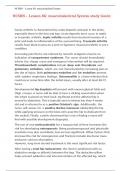
NCSBN – Lesson 8G: musculoskeletal System study Guide,100% CORRECT
NCSBN – Lesson 8G: musculoskeletal System study Guide Gouty arthritis is characterized by urate deposits and pain in the joints, especially those in the feet and legs. Urate deposits don't occur in septic or traumatic arthritis. Septic arthritis results from bacterial invasion of a joint and leads to inflammation of the synovial lining. Traumatic arthritis results from blunt trauma to a joint or ligament. Seasonal arthritis is not a condition. Increasing pain that is not relieved by nar...
- Exam (elaborations)
- • 78 pages •
NCSBN – Lesson 8G: musculoskeletal System study Guide Gouty arthritis is characterized by urate deposits and pain in the joints, especially those in the feet and legs. Urate deposits don't occur in septic or traumatic arthritis. Septic arthritis results from bacterial invasion of a joint and leads to inflammation of the synovial lining. Traumatic arthritis results from blunt trauma to a joint or ligament. Seasonal arthritis is not a condition. Increasing pain that is not relieved by nar...

NCSBN –Lesson 8E:Genitourinary System Study Guide,100% CORRECT
NCSBN –Lesson 8E:Genitourinary System Study Guide Due to an increase in sensitivity to insulin, rapid fetal growth and a reduction in eating associated with “morning sickness,” women with pre-existing diabetes have a higher risk of hypoglycemia and will need decreased amounts of insulin. In the second trimester, the placenta is fully developed and hormone levels being to rise steadily, which increases maternal insulin needs. In the third trimester, insulin is absorbed more slowly and is...
- Exam (elaborations)
- • 53 pages •
NCSBN –Lesson 8E:Genitourinary System Study Guide Due to an increase in sensitivity to insulin, rapid fetal growth and a reduction in eating associated with “morning sickness,” women with pre-existing diabetes have a higher risk of hypoglycemia and will need decreased amounts of insulin. In the second trimester, the placenta is fully developed and hormone levels being to rise steadily, which increases maternal insulin needs. In the third trimester, insulin is absorbed more slowly and is...
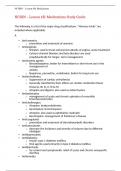
NCSBN – Lesson 6B: Medications Study Guide ,100% CORRECT
NCSBN – Lesson 6B: Medications Study Guide The following is a list of the major drug classifications. "Memory tricks" are included where applicable. A • Anti-anemics o prevention and treatment of anemias • Antianginals: o Nitrates: used to treat and prevent attacks of angina; acute treatment o Calcium channel blockers and beta blockers are used prophylactically for longer- term management • Antianxiety agents: o Benzodiazepines: better for intermittent or short-term use in ...
- Exam (elaborations)
- • 28 pages •
NCSBN – Lesson 6B: Medications Study Guide The following is a list of the major drug classifications. "Memory tricks" are included where applicable. A • Anti-anemics o prevention and treatment of anemias • Antianginals: o Nitrates: used to treat and prevent attacks of angina; acute treatment o Calcium channel blockers and beta blockers are used prophylactically for longer- term management • Antianxiety agents: o Benzodiazepines: better for intermittent or short-term use in ...
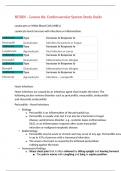
NCSBN – Lesson 8A: Cardiovascular System Study Guide,100% CORRECT
NCSBN – Lesson 8A: Cardiovascular System Study Guide Leukocytes or White Blood Cells (WBCs) Leukocyte levels increase with infections or inflammation. Leukocyte Type Granulocyte Increases in Response to Infection by bacteria or fungus Neutrophil Leukocyte Type Agranulocyte Increases in Response to Viral infection or tumor Lymphocyte Leukocyte Type Granulocyte Increases in Response to Inflammation from allergies Eosinophil Leukocyte Type Granulocyte Increases in Respo...
- Exam (elaborations)
- • 108 pages •
NCSBN – Lesson 8A: Cardiovascular System Study Guide Leukocytes or White Blood Cells (WBCs) Leukocyte levels increase with infections or inflammation. Leukocyte Type Granulocyte Increases in Response to Infection by bacteria or fungus Neutrophil Leukocyte Type Agranulocyte Increases in Response to Viral infection or tumor Lymphocyte Leukocyte Type Granulocyte Increases in Response to Inflammation from allergies Eosinophil Leukocyte Type Granulocyte Increases in Respo...
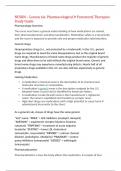
NCSBN – Lesson 6A: Pharmacological & Parenteral Therapies Study Guide,100% CORRECT
NCSBN – Lesson 6A: Pharmacological & Parenteral Therapies Study Guide Pharmacology Overview The nurse must have a general understanding of how medications are named, their pharmacodynamics and pharmacokinetics. Medication safety is a top priority and the nurse is expected to provide safe and proper medication adminstration. Generic drugs Nonproprietary drugs (i.e., not protected by a trademark). In the U.S., generic drugs are required to meet the same bioequivalency test as the original br...
- Exam (elaborations)
- • 24 pages •
NCSBN – Lesson 6A: Pharmacological & Parenteral Therapies Study Guide Pharmacology Overview The nurse must have a general understanding of how medications are named, their pharmacodynamics and pharmacokinetics. Medication safety is a top priority and the nurse is expected to provide safe and proper medication adminstration. Generic drugs Nonproprietary drugs (i.e., not protected by a trademark). In the U.S., generic drugs are required to meet the same bioequivalency test as the original br...
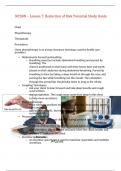
NCSBN – Lesson 7: Reduction of Risk Potential Study Guide,100% CORRECT
NCSBN – Lesson 7: Reduction of Risk Potential Study Guide Chest Physiotherapy Therapeutic Procedures Chest physiotherapy is an airway clearance technique used by health care providers. • Abdominal & Pursed Lip Breathing o Breathing exercises include abdominal breathing and pursed lip breathing. The client is positioned on their back with their knees bent and hands placed on their abdomen during abdominal breathing. Pursed lip breathing is done by taking a deep breath in through the no...
- Exam (elaborations)
- • 116 pages •
NCSBN – Lesson 7: Reduction of Risk Potential Study Guide Chest Physiotherapy Therapeutic Procedures Chest physiotherapy is an airway clearance technique used by health care providers. • Abdominal & Pursed Lip Breathing o Breathing exercises include abdominal breathing and pursed lip breathing. The client is positioned on their back with their knees bent and hands placed on their abdomen during abdominal breathing. Pursed lip breathing is done by taking a deep breath in through the no...
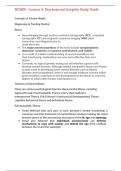
NCSBN – Lesson 4: Psychosocial Integrity Study Guide,100% CORRECT
NCSBN – Lesson 4: Psychosocial Integrity Study Guide Concepts of Mental Health Diagnosing & Treating Mental Illness • Neuroimaging through positron emission tomography (PET), computed tomography (CT) and magnetic resonance imaging (MRI) allow researchers and diagnosticians to study the brain. • The major neurotransmitters of the brain include norepinephrine, dopamine, serotonin and gamma-aminobutyric acid (GABA). • As a result of a better understanding of neurotransmitters and the...
- Exam (elaborations)
- • 78 pages •
NCSBN – Lesson 4: Psychosocial Integrity Study Guide Concepts of Mental Health Diagnosing & Treating Mental Illness • Neuroimaging through positron emission tomography (PET), computed tomography (CT) and magnetic resonance imaging (MRI) allow researchers and diagnosticians to study the brain. • The major neurotransmitters of the brain include norepinephrine, dopamine, serotonin and gamma-aminobutyric acid (GABA). • As a result of a better understanding of neurotransmitters and the...
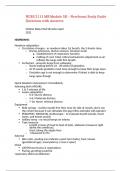
NURS 2111 MB Module 5B – Newborns Study Guide Questions with Answers,100% CORRECT
NURS 2111 MB Module 5B – Newborns Study Guide Questions with Answers Mother Baby Mod 5B notes April 2021 NEWBORNS: Newborn adaptation: • Circulatory changes - as newborn takes 1st breath, the 3 shunts close o Ductus arteriosus, ductus venosus, foramen ovale ▪ Establishment of respiratory function ▪ Cutting of cord- Most critical extrauterine adjustment as air inflates the lungs with first breath • Surfactant - prevents lungs from collapsing o Starts making before 24 - 28 w...
- Exam (elaborations)
- • 23 pages •
NURS 2111 MB Module 5B – Newborns Study Guide Questions with Answers Mother Baby Mod 5B notes April 2021 NEWBORNS: Newborn adaptation: • Circulatory changes - as newborn takes 1st breath, the 3 shunts close o Ductus arteriosus, ductus venosus, foramen ovale ▪ Establishment of respiratory function ▪ Cutting of cord- Most critical extrauterine adjustment as air inflates the lungs with first breath • Surfactant - prevents lungs from collapsing o Starts making before 24 - 28 w...
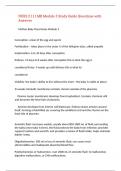
NURS 2111 MB Module 3 Study Guide Questions with Answers,100% CORRECT
NURS 2111 MB Module 3 Study Guide Questions with Answers Mother Baby Class Notes Module 3 Conception- union of the egg and sperm Fertilization – takes place in the outer ⅓ of the fallopian tube, called ampulla Implantation- 6 to 10 days after conception Embryo- 15 days to 8 weeks after conception this is what the egg is considered Fetus- 9 weeks up until delivery this is what its considered Viability- the baby’s ability to live without the mom-- the baby is viable at about 24...
- Exam (elaborations)
- • 43 pages •
NURS 2111 MB Module 3 Study Guide Questions with Answers Mother Baby Class Notes Module 3 Conception- union of the egg and sperm Fertilization – takes place in the outer ⅓ of the fallopian tube, called ampulla Implantation- 6 to 10 days after conception Embryo- 15 days to 8 weeks after conception this is what the egg is considered Fetus- 9 weeks up until delivery this is what its considered Viability- the baby’s ability to live without the mom-- the baby is viable at about 24...
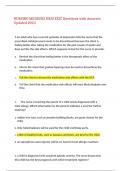
NURSING MEDSUR2 HESI EXIT Questions with Answers Updated 2023,100% CORRECT
NURSING MEDSUR2 HESI EXIT Questions with Answers Updated 2023 1.An adult who has recurrent episodes of depression tells the nurse that the prescribed antidepressant needs to be discontinued because the client is feeling better after taking the medication for the past couple of weeks and does not like the side effects. Which response is best for the nurse to provide. a. Remind the client that feeling better is the therapeutic effect of the medication. b. Inform the client that gradua...
- Exam (elaborations)
- • 57 pages •
NURSING MEDSUR2 HESI EXIT Questions with Answers Updated 2023 1.An adult who has recurrent episodes of depression tells the nurse that the prescribed antidepressant needs to be discontinued because the client is feeling better after taking the medication for the past couple of weeks and does not like the side effects. Which response is best for the nurse to provide. a. Remind the client that feeling better is the therapeutic effect of the medication. b. Inform the client that gradua...

Pharmacology Clear and Simple- A Guide to Drug Classifications and Dosage Calculations 3rd Edition Watkins Test Bank
Chicago State University: NURS MISC Exam 3 Questions and Answers,100% CORRECT
NURS 3320 Test Bank Intravenous Therapy Questions and Answers and Rationale,100% CORRECT
Thankful
AANP Board Questions AND ANSWERS| A RATED
AANP review Questions and ANSWERS (100 % CORRECT)